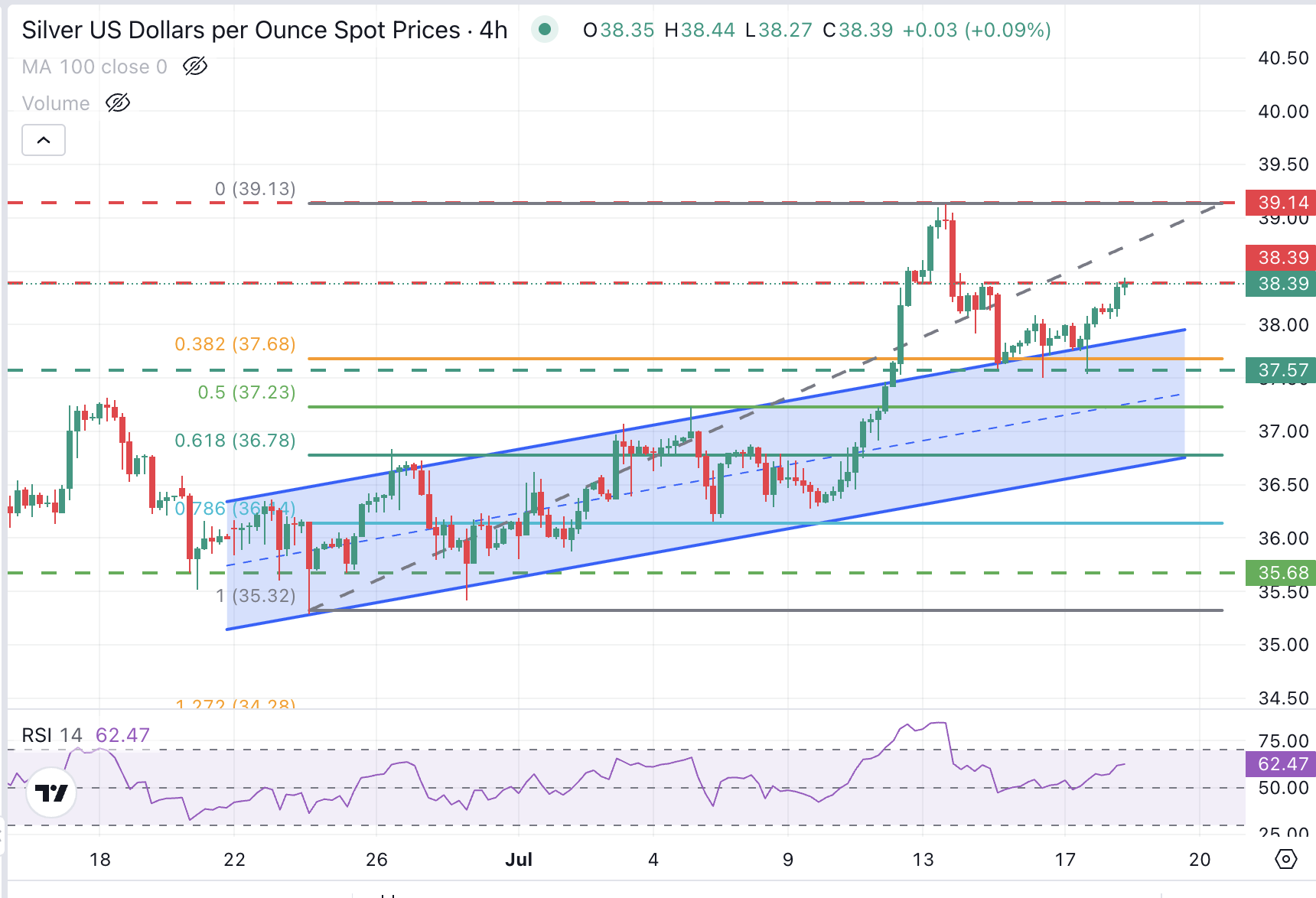Silver Price Forecast: XAG/USD rallies to $38.40 favoured by a softer US Dollar
- Silver extends gains for the third day in a row, buoyed by US Dollar weakness.
- Upbeat US corporate earnings and dovish Fedspeak are weighing on the safe-haven US Dollar.
- XAG/USD corrective reversal has been capped above previous highs, at the $37.55 area.
Silver (XAG/USD) is rallying for the third consecutive day on Friday, with bulls testing July 15 highs of 38.40 at the time of writing, as the US Dollar falls alongside US Treasury yields amid higher risk appetite.
Corporate earnings reports from Netflix, the Chipmaker TSMC, PepsiCo, and United Airlines, among others, beat market expectations on Thursday, boosting demand for equities and risk-sensitive assets to the detriment of safe havens like the US Dollar.
These reports, coupled with dovish comments from Fed Governour Christopher Waller, who maintained that the bank should cut interest rates in July, citing downside risks for the labour market and economic growth, are contributing to keeping the US Dollar on the defensive on Friday.
Technical Analysis: Correcting lower within a broader bullish trend

From a technical perspective, the pair´s corrective reversal from long-term highs above $39.00 has been capped above the reverse trendline of a previous bullish channel, and the pair is trading higher again.
Bulls are testing the 15 July high at $38.40, with the 4-hour RSI steady at levels above 50, which suggests that further appreciation is likely. A confirmation above that level brings the July 14 high, at $39.15, to the focus.
A rejection from current levels, on the contrary, might find support at the mentioned trendline, now at $37.8, ahead of the July 15, 16, and 17 lows, at $37,60. Below here, the 50% Fibonacci retracement of the June-July rally, and the July 6 low, at $37.25, might attract selling pressure.
Silver FAQs
Silver is a precious metal highly traded among investors. It has been historically used as a store of value and a medium of exchange. Although less popular than Gold, traders may turn to Silver to diversify their investment portfolio, for its intrinsic value or as a potential hedge during high-inflation periods. Investors can buy physical Silver, in coins or in bars, or trade it through vehicles such as Exchange Traded Funds, which track its price on international markets.
Silver prices can move due to a wide range of factors. Geopolitical instability or fears of a deep recession can make Silver price escalate due to its safe-haven status, although to a lesser extent than Gold's. As a yieldless asset, Silver tends to rise with lower interest rates. Its moves also depend on how the US Dollar (USD) behaves as the asset is priced in dollars (XAG/USD). A strong Dollar tends to keep the price of Silver at bay, whereas a weaker Dollar is likely to propel prices up. Other factors such as investment demand, mining supply – Silver is much more abundant than Gold – and recycling rates can also affect prices.
Silver is widely used in industry, particularly in sectors such as electronics or solar energy, as it has one of the highest electric conductivity of all metals – more than Copper and Gold. A surge in demand can increase prices, while a decline tends to lower them. Dynamics in the US, Chinese and Indian economies can also contribute to price swings: for the US and particularly China, their big industrial sectors use Silver in various processes; in India, consumers’ demand for the precious metal for jewellery also plays a key role in setting prices.
Silver prices tend to follow Gold's moves. When Gold prices rise, Silver typically follows suit, as their status as safe-haven assets is similar. The Gold/Silver ratio, which shows the number of ounces of Silver needed to equal the value of one ounce of Gold, may help to determine the relative valuation between both metals. Some investors may consider a high ratio as an indicator that Silver is undervalued, or Gold is overvalued. On the contrary, a low ratio might suggest that Gold is undervalued relative to Silver.

